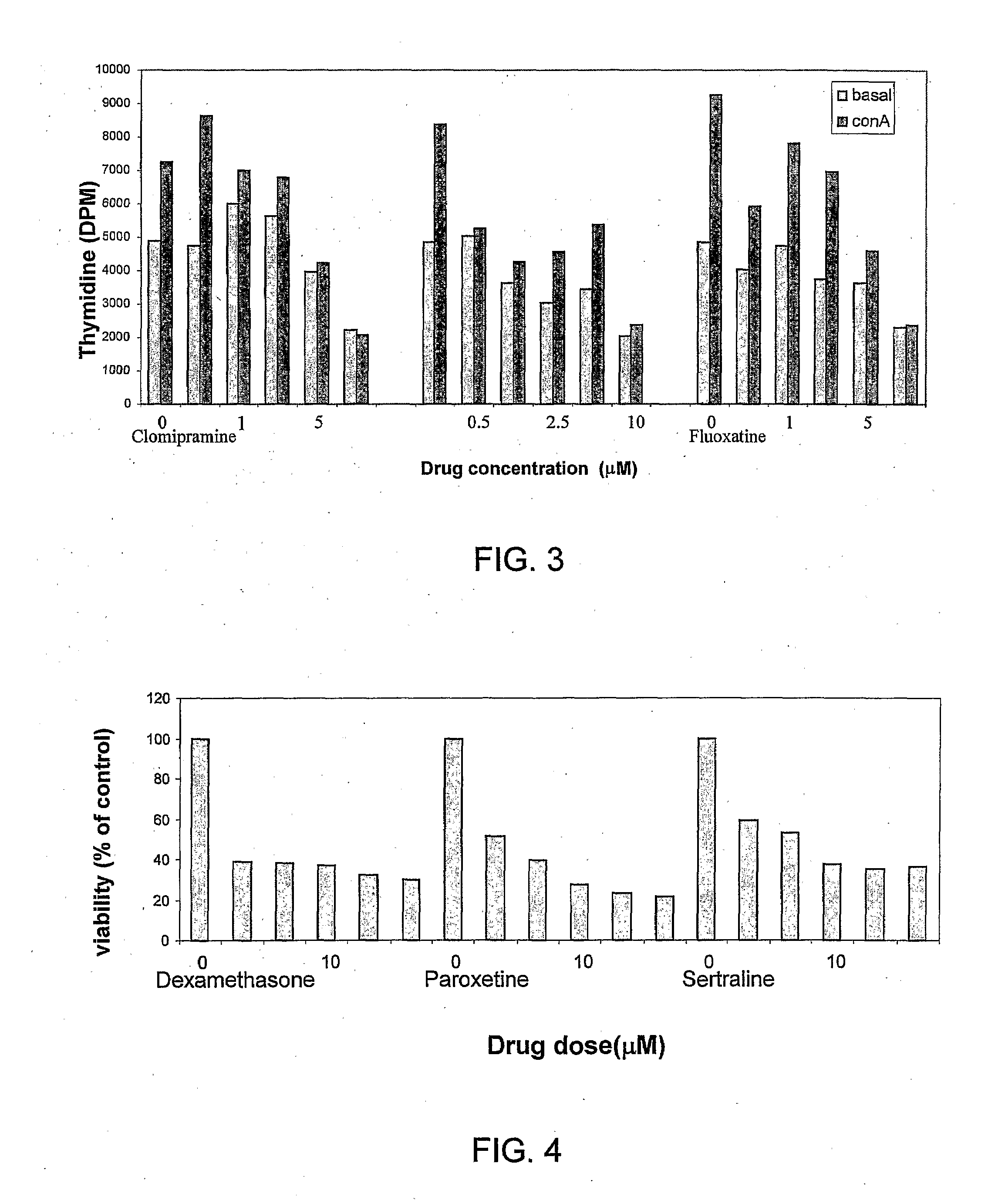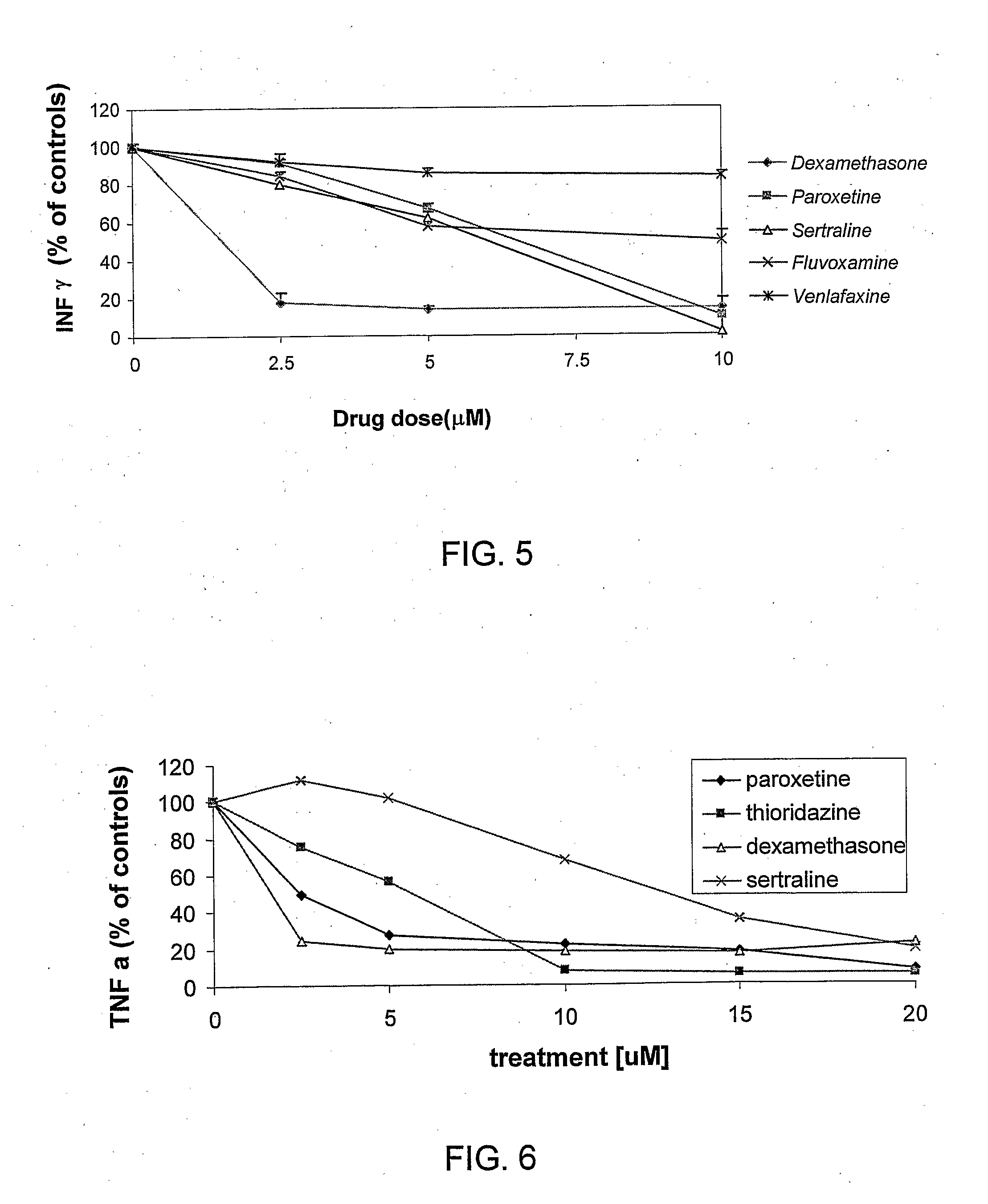Treatment of Disorders and Diseases of the Colon
a colon disease and colon disease technology, applied in the field of colon disease drugs, can solve the problems of infliximab (commercially available as remicade®), which is expensive and requires careful monitoring, and the systemic antidepressant therapy is only modest, and achieves the effect of reducing the side effects of the central nervous system or the cardiovascular system, and reducing the side effects
- Summary
- Abstract
- Description
- Claims
- Application Information
AI Technical Summary
Benefits of technology
Problems solved by technology
Method used
Image
Examples
example 1
Effect of the Antidepressants Paroxetine (SSRI) and Clomipramine TCA) as Compared to Dexamethasone at Concentrations of 2.5-10 μM on Basal and Concavalin A- (ConA) 5 μM Induced Cell Proliferation
[0102]Mouse splenocytes were isolated from C57b1 healthy female mice. Cells (10,000 / well) were tested under basal and ConA stimulation. Cells were treated with vehicle, dexamethasone or antidepressants (2.5-10 μM). Viability was assessed 48 hr later using alamar blue staining. (Reagents were manufactured by Wildflower, Santa Fe, N. Mex., USA.) Alamar blue assay was performed as in Nociari et al (1998).
[0103]Results were plotted in FIG. 1, wherein each point is the mean of 4 determinations.
[0104]The data demonstrates that the SSRI paroxetine and the TCA clomipramine induced a dose dependent decrease in the basal and the mitogen-induced splenocyte proliferation resembling the pattern produced by the corticosteroid dexamethasone (shown for reference only).
example 2
Effects of Paroxetine and Clomipramine on Con-A-Induced Mouse Splenocyte Proliferation and Secretion of IL-2 and INF-γ
[0105]Effect of paroxetine, (SSRI) and clomipramine (TCA) as compared to dexamethasone on Con-A-induced splenocyte proliferation (alamar blue method), and splenocyte-induced secretion of TH1 cytokines TNF-α, IL2 and INFγ, 1×106 cells / well, was measured 48 hours after exposure to drugs (2.5-10 μM).
[0106]Cytokines were determined in the supernatant of the splenocyte specimens using an ELISA kit and protocol (Reagents by Cytolab). As may be concluded from FIG. 2, paroxetine (SSRI) and clomipramine (TCA) caused a dose-dependent decrease in splenocyte proliferation, which led to a decrease in the level of lymphocyte-induced pro-inflammatory cytokine secretion. The pattern observed resembles that of dexamethasone. Thus, the results indicate that SSRI and the TCA agents produce glucocorticosteroid-like anti-inflammatory effects.
example 3
Effect of the SSRIs Paroxetine and Fluoxetine and TCA Clomipramine on Basal and ConA-Induced Splenocytes Proliferation as Measured by Thymidine Incorporation
[0107]Mouse splenocytes were isolated from C57b1 healthy female mice. Cells (10,000 / well) were tested under basal and ConA stimulation. Cells were treated with vehicle, or antidepressants (2.5-10 μM). 3H-thymidine, 1 μCi / ml, was added to the cells for 24 hr, after which period the cells were harvested and the incorporate radioactivity was determined by a liquid scintillation beta counter.
[0108]Each point on the graph is the mean of 4 determinations. The results shown in FIG. 3 indicate that all 3 antidepressants induced a decrease in incorporated 3H-thymidine. The effect was noted even at the low antidepressant concentration of 0.5-1 μM. A more pronounced effect of inhibition was observed in the mitogen-induced proliferation (as reflected by the finding that at 10 μM, the level of proliferation of basal and stimulated cells was ...
PUM
| Property | Measurement | Unit |
|---|---|---|
| weight | aaaaa | aaaaa |
| weight | aaaaa | aaaaa |
| diameter | aaaaa | aaaaa |
Abstract
Description
Claims
Application Information
 Login to View More
Login to View More - R&D
- Intellectual Property
- Life Sciences
- Materials
- Tech Scout
- Unparalleled Data Quality
- Higher Quality Content
- 60% Fewer Hallucinations
Browse by: Latest US Patents, China's latest patents, Technical Efficacy Thesaurus, Application Domain, Technology Topic, Popular Technical Reports.
© 2025 PatSnap. All rights reserved.Legal|Privacy policy|Modern Slavery Act Transparency Statement|Sitemap|About US| Contact US: help@patsnap.com



